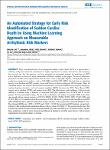Item Infomation

| Title: | An Automated Strategy for Early Risk Identification of Sudden Cardiac Death by Using Machine Learning Approach on Measurable Arrhythmic Risk Markers |
| Authors: | Lai, D. |
| Participants: | Zhang, Y. Zhang, X. Su, Y. Heyat, M. B. Bin |
| Issue Date: | 2019 |
| Publisher: | IEEE Xplore |
| Citation: | IEEE Access, (2019), Volume 7, pp 94701-94716 |
| Abstract: | ABSTRACT Early risk identi cation of an unexpected sudden cardiac death (SCD) in a person who is suffering malignant ventricular arrhythmias is highly signi cant for timely intervention and increasing the survival rate. For this purpose, we have presented an automated strategy for prediction of SCD with a high-level accuracy by using measurable arrhythmic markers in this paper. The set of arrhythmic parameters includes three repolarization interval ratios, such as TpTe/QT, JTp/JTe, and T and two conduction-repolarization markers, such as TpTe/QRS and TpT/(QT QRS). Each of them is calculated directly from the detected QRS complex waves and T-wave of electrocradiogram (ECG) signals. Then, all calculated markers are used for the automatical classi cation of normal and SCD risk groups by employing machine learning classi ers, such as k-nearest neighbor (KNN), decision tree (DT), Naive Bayes (NB), support vector machine (SVM), and random forest (RF). The effectiveness and usefulness of the proposed method is evaluated using a database of measured ECG data acquired from 28 SCD and 18 normal patients. For the automated strategy, the set of ve arrhythmic risk markers can predict SCD in less than one second with an average accuracy of 98.91% (KNN), 98.70% (SVM), 98.99% (DT), 97.46% (NB), and 99.49% (RF) for 30 minutes before the occurrence of SCD. Moreover, a practical and straightforward SCD index (SCDI) through a judicious integration of these markers is also proposed by using the Student's t-test. The obtained SCDIs are 1.2058 0.0795 and 1.7619 0.1902 for normal and SCD patients, respectively, which provide a suf cient discrimination degree with a p-value of 6.5061e-35. The present results show that both the automated classi er and the integrated SCDI can predict the SCD up to 30 minutes earlier, and that these predictions could be more practical and ef cient if applied in portable smart devices with real-time requirements in hospital settings or at home. |
| URI: | http://tailieuso.tlu.edu.vn/handle/DHTL/9782 |
| Source: | http://doi.org/10.1109/ACCESS.2019.2925847 |
| Appears in Collections: | Tài liệu hỗ trợ nghiên cứu khoa học |
ABSTRACTS VIEWS
25
VIEWS & DOWNLOAD
6
Files in This Item:
Bạn đọc là cán bộ, giáo viên, sinh viên của Trường Đại học Thuỷ Lợi cần đăng nhập để Xem trực tuyến/Tải về
Items in DSpace are protected by copyright, with all rights reserved, unless otherwise indicated.
